Evaluating Quality of Urban Transport in Delhi: ENN 515 Report 2018
VerifiedAdded on 2021/04/16
|37
|8638
|35
Report
AI Summary
This report provides a comprehensive analysis of the quality of urban transport in Delhi, focusing on the challenges and opportunities within the city's public transportation system. The report begins with an introduction highlighting the increasing demand for transport facilities due to economic and social development, and the pressure on Delhi's transport infrastructure. It then reviews relevant literature, specifically Total Quality Management (TQM) and its application in urban transport, emphasizing the importance of customer satisfaction, continuous improvement, and safety. The report details the data collection methods, including observations and interviews, and examines key aspects such as safety, comfort, and time accuracy of public transport, particularly the DTC bus network and the Delhi Metro. The report also explores the implementation of ISO 9000 standards and draws lessons from Brisbane's public transport system. Furthermore, it proposes solutions and recommendations to improve the efficiency, safety, and overall quality of urban transport in Delhi, including the need for increased safety measures, enhanced last-mile connectivity, and the deployment of trained personnel. The report concludes by emphasizing the need for efficient and customer-oriented services to meet the growing demands of Delhi's population.
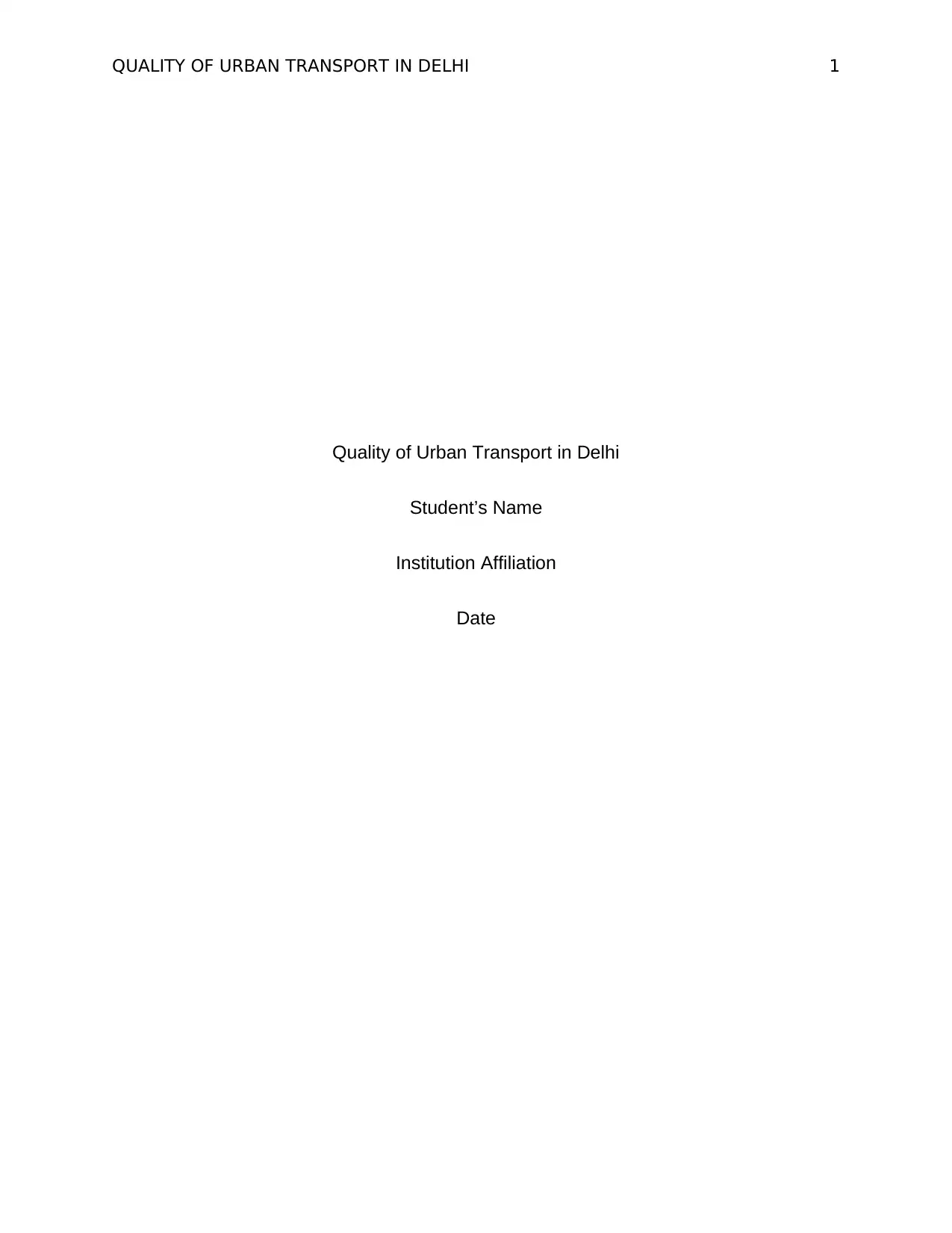
QUALITY OF URBAN TRANSPORT IN DELHI 1
Quality of Urban Transport in Delhi
Student’s Name
Institution Affiliation
Date
Quality of Urban Transport in Delhi
Student’s Name
Institution Affiliation
Date
Paraphrase This Document
Need a fresh take? Get an instant paraphrase of this document with our AI Paraphraser
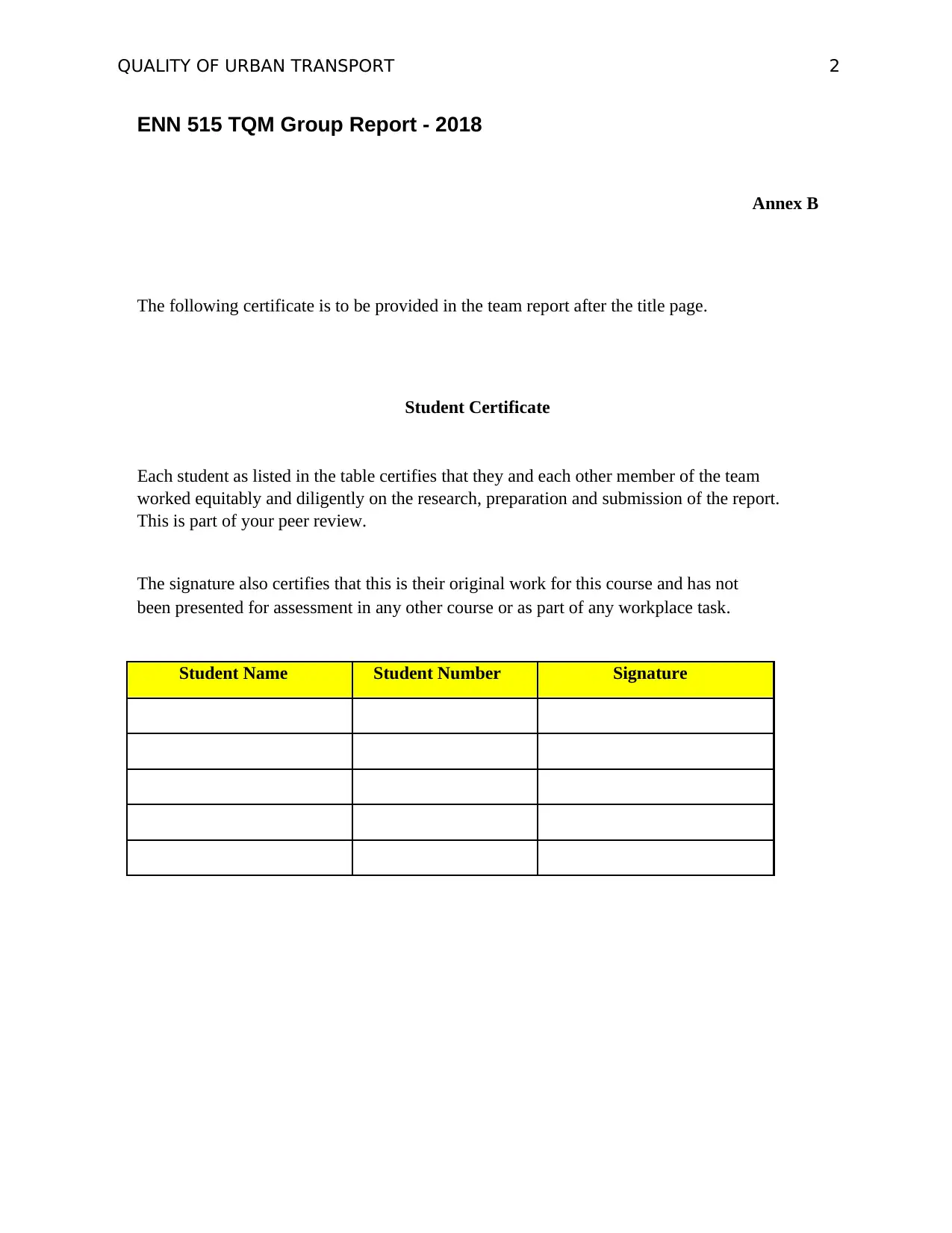
QUALITY OF URBAN TRANSPORT 2
ENN 515 TQM Group Report - 2018
Annex B
The following certificate is to be provided in the team report after the title page.
Student Certificate
Each student as listed in the table certifies that they and each other member of the team
worked equitably and diligently on the research, preparation and submission of the report.
This is part of your peer review.
The signature also certifies that this is their original work for this course and has not
been presented for assessment in any other course or as part of any workplace task.
Student Name Student Number Signature
ENN 515 TQM Group Report - 2018
Annex B
The following certificate is to be provided in the team report after the title page.
Student Certificate
Each student as listed in the table certifies that they and each other member of the team
worked equitably and diligently on the research, preparation and submission of the report.
This is part of your peer review.
The signature also certifies that this is their original work for this course and has not
been presented for assessment in any other course or as part of any workplace task.
Student Name Student Number Signature
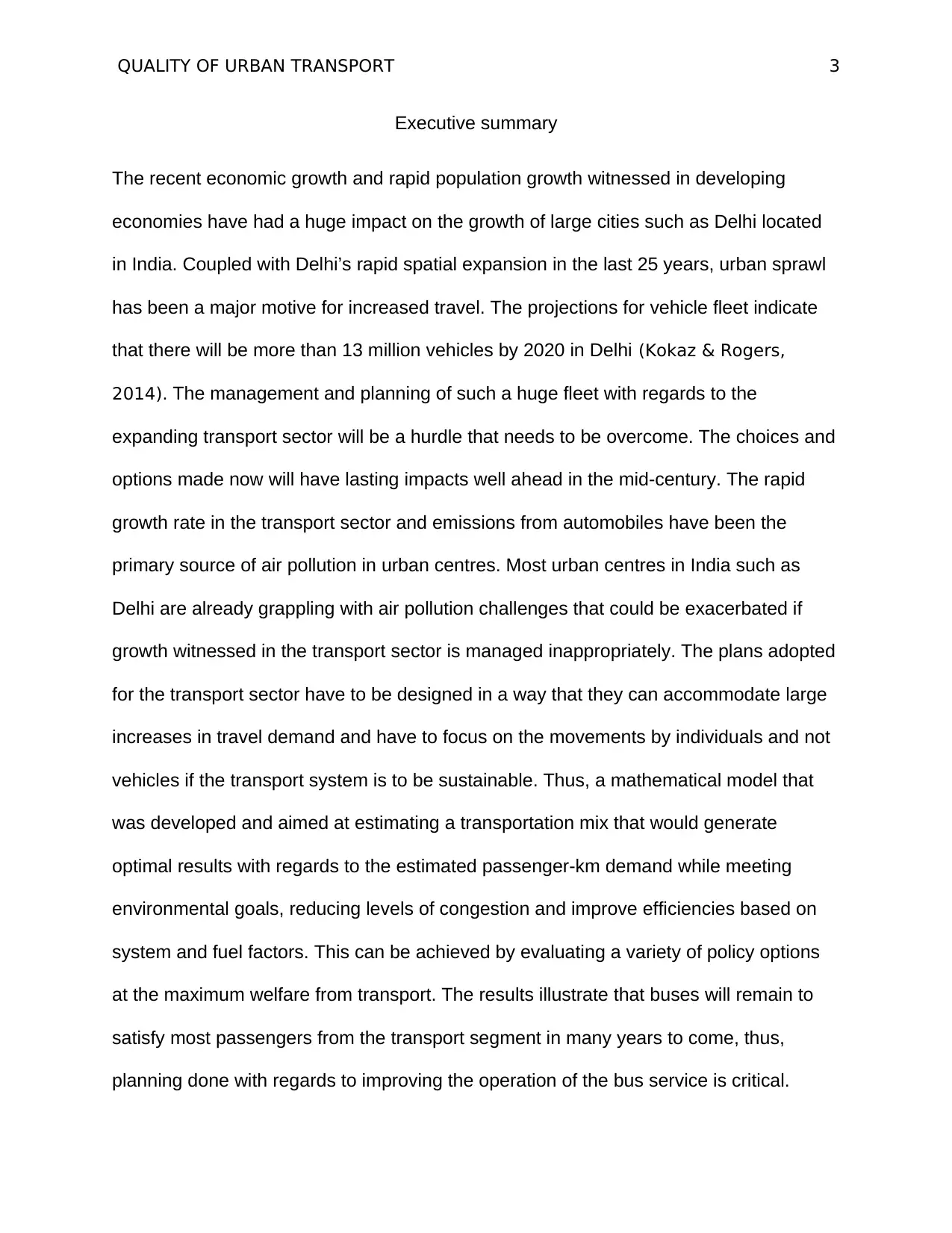
QUALITY OF URBAN TRANSPORT 3
Executive summary
The recent economic growth and rapid population growth witnessed in developing
economies have had a huge impact on the growth of large cities such as Delhi located
in India. Coupled with Delhi’s rapid spatial expansion in the last 25 years, urban sprawl
has been a major motive for increased travel. The projections for vehicle fleet indicate
that there will be more than 13 million vehicles by 2020 in Delhi (Kokaz & Rogers,
2014). The management and planning of such a huge fleet with regards to the
expanding transport sector will be a hurdle that needs to be overcome. The choices and
options made now will have lasting impacts well ahead in the mid-century. The rapid
growth rate in the transport sector and emissions from automobiles have been the
primary source of air pollution in urban centres. Most urban centres in India such as
Delhi are already grappling with air pollution challenges that could be exacerbated if
growth witnessed in the transport sector is managed inappropriately. The plans adopted
for the transport sector have to be designed in a way that they can accommodate large
increases in travel demand and have to focus on the movements by individuals and not
vehicles if the transport system is to be sustainable. Thus, a mathematical model that
was developed and aimed at estimating a transportation mix that would generate
optimal results with regards to the estimated passenger-km demand while meeting
environmental goals, reducing levels of congestion and improve efficiencies based on
system and fuel factors. This can be achieved by evaluating a variety of policy options
at the maximum welfare from transport. The results illustrate that buses will remain to
satisfy most passengers from the transport segment in many years to come, thus,
planning done with regards to improving the operation of the bus service is critical.
Executive summary
The recent economic growth and rapid population growth witnessed in developing
economies have had a huge impact on the growth of large cities such as Delhi located
in India. Coupled with Delhi’s rapid spatial expansion in the last 25 years, urban sprawl
has been a major motive for increased travel. The projections for vehicle fleet indicate
that there will be more than 13 million vehicles by 2020 in Delhi (Kokaz & Rogers,
2014). The management and planning of such a huge fleet with regards to the
expanding transport sector will be a hurdle that needs to be overcome. The choices and
options made now will have lasting impacts well ahead in the mid-century. The rapid
growth rate in the transport sector and emissions from automobiles have been the
primary source of air pollution in urban centres. Most urban centres in India such as
Delhi are already grappling with air pollution challenges that could be exacerbated if
growth witnessed in the transport sector is managed inappropriately. The plans adopted
for the transport sector have to be designed in a way that they can accommodate large
increases in travel demand and have to focus on the movements by individuals and not
vehicles if the transport system is to be sustainable. Thus, a mathematical model that
was developed and aimed at estimating a transportation mix that would generate
optimal results with regards to the estimated passenger-km demand while meeting
environmental goals, reducing levels of congestion and improve efficiencies based on
system and fuel factors. This can be achieved by evaluating a variety of policy options
at the maximum welfare from transport. The results illustrate that buses will remain to
satisfy most passengers from the transport segment in many years to come, thus,
planning done with regards to improving the operation of the bus service is critical.
⊘ This is a preview!⊘
Do you want full access?
Subscribe today to unlock all pages.

Trusted by 1+ million students worldwide
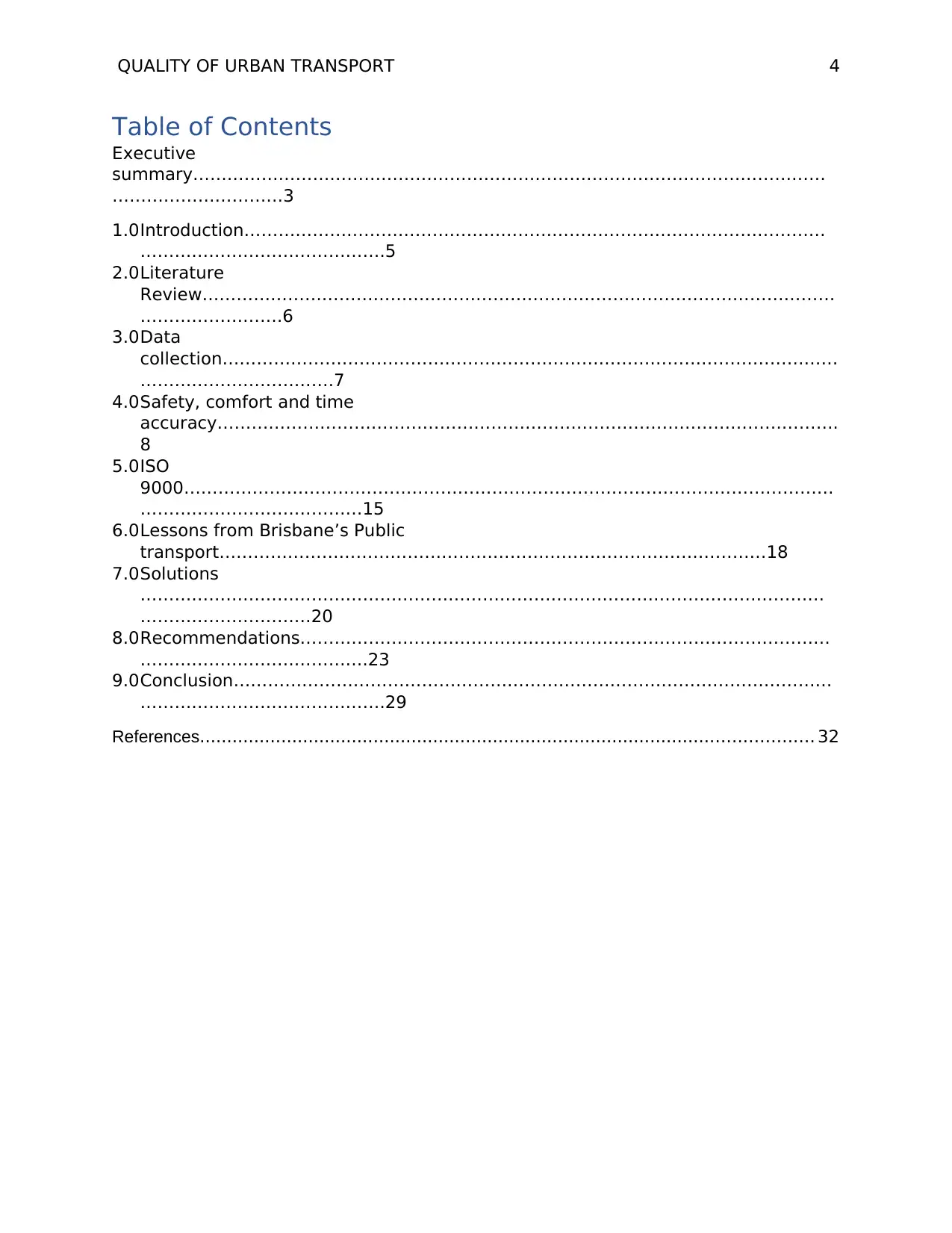
QUALITY OF URBAN TRANSPORT 4
Table of Contents
Executive
summary…………………………………………………………………………………………………
…………………………3
1.0Introduction…………………………………………………………………………………………
…………………………………….5
2.0Literature
Review…………………………………………………………………………………………………
…………………….6
3.0Data
collection………………………………………………………………………………………………
…………………………….7
4.0Safety, comfort and time
accuracy……………………………………………………………………………………………….
8
5.0ISO
9000……………………………………………………………………………………………………
…………………………………15
6.0Lessons from Brisbane’s Public
transport……………………………………………………………………………………18
7.0Solutions
…………………………………………………………………………………………………………
…………………………20
8.0Recommendations…………………………………………………………………………………
………………………………….23
9.0Conclusion……………………………………………………………………………………………
…………………………………….29
References................................................................................................................. 32
Table of Contents
Executive
summary…………………………………………………………………………………………………
…………………………3
1.0Introduction…………………………………………………………………………………………
…………………………………….5
2.0Literature
Review…………………………………………………………………………………………………
…………………….6
3.0Data
collection………………………………………………………………………………………………
…………………………….7
4.0Safety, comfort and time
accuracy……………………………………………………………………………………………….
8
5.0ISO
9000……………………………………………………………………………………………………
…………………………………15
6.0Lessons from Brisbane’s Public
transport……………………………………………………………………………………18
7.0Solutions
…………………………………………………………………………………………………………
…………………………20
8.0Recommendations…………………………………………………………………………………
………………………………….23
9.0Conclusion……………………………………………………………………………………………
…………………………………….29
References................................................................................................................. 32
Paraphrase This Document
Need a fresh take? Get an instant paraphrase of this document with our AI Paraphraser
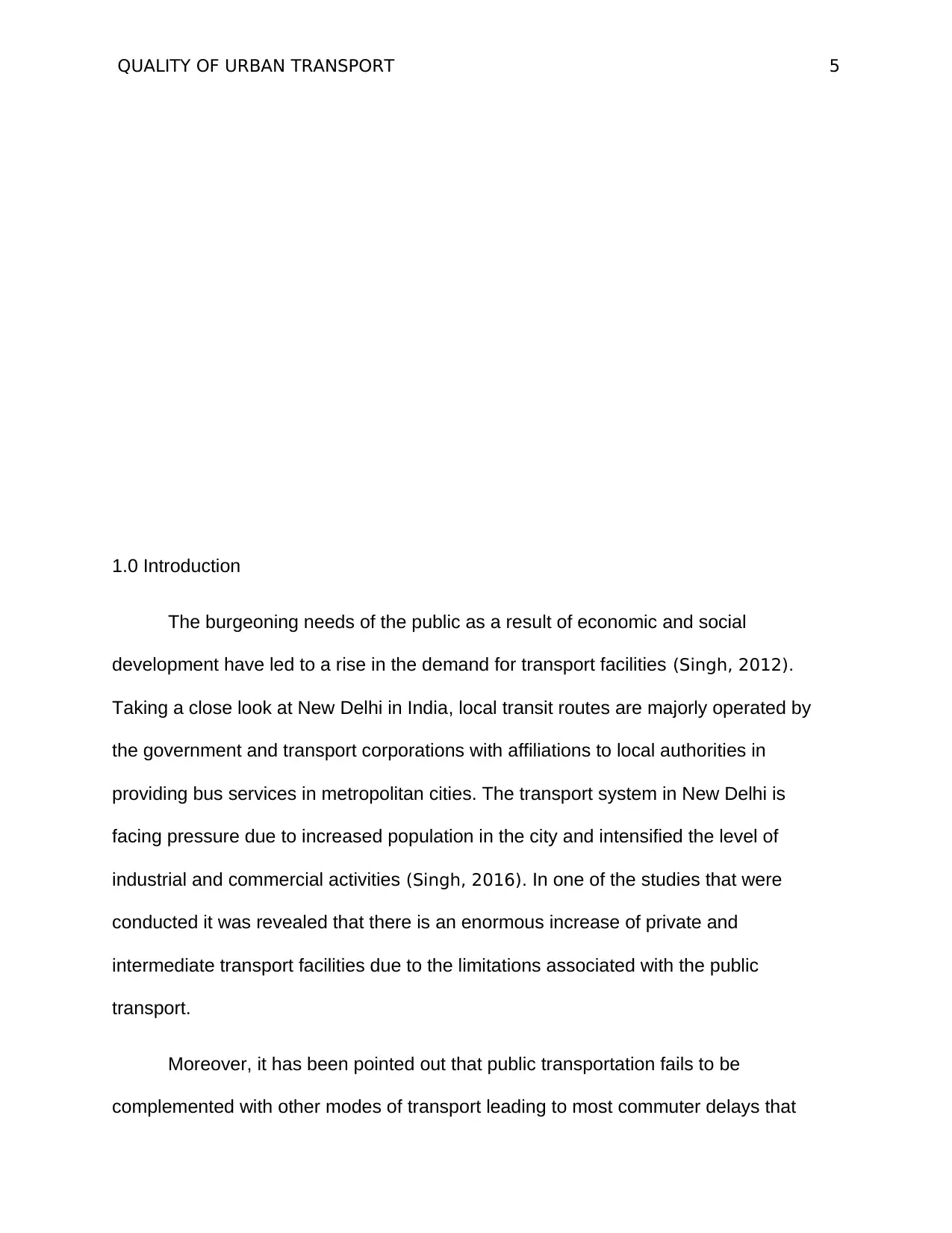
QUALITY OF URBAN TRANSPORT 5
1.0 Introduction
The burgeoning needs of the public as a result of economic and social
development have led to a rise in the demand for transport facilities (Singh, 2012).
Taking a close look at New Delhi in India, local transit routes are majorly operated by
the government and transport corporations with affiliations to local authorities in
providing bus services in metropolitan cities. The transport system in New Delhi is
facing pressure due to increased population in the city and intensified the level of
industrial and commercial activities (Singh, 2016). In one of the studies that were
conducted it was revealed that there is an enormous increase of private and
intermediate transport facilities due to the limitations associated with the public
transport.
Moreover, it has been pointed out that public transportation fails to be
complemented with other modes of transport leading to most commuter delays that
1.0 Introduction
The burgeoning needs of the public as a result of economic and social
development have led to a rise in the demand for transport facilities (Singh, 2012).
Taking a close look at New Delhi in India, local transit routes are majorly operated by
the government and transport corporations with affiliations to local authorities in
providing bus services in metropolitan cities. The transport system in New Delhi is
facing pressure due to increased population in the city and intensified the level of
industrial and commercial activities (Singh, 2016). In one of the studies that were
conducted it was revealed that there is an enormous increase of private and
intermediate transport facilities due to the limitations associated with the public
transport.
Moreover, it has been pointed out that public transportation fails to be
complemented with other modes of transport leading to most commuter delays that
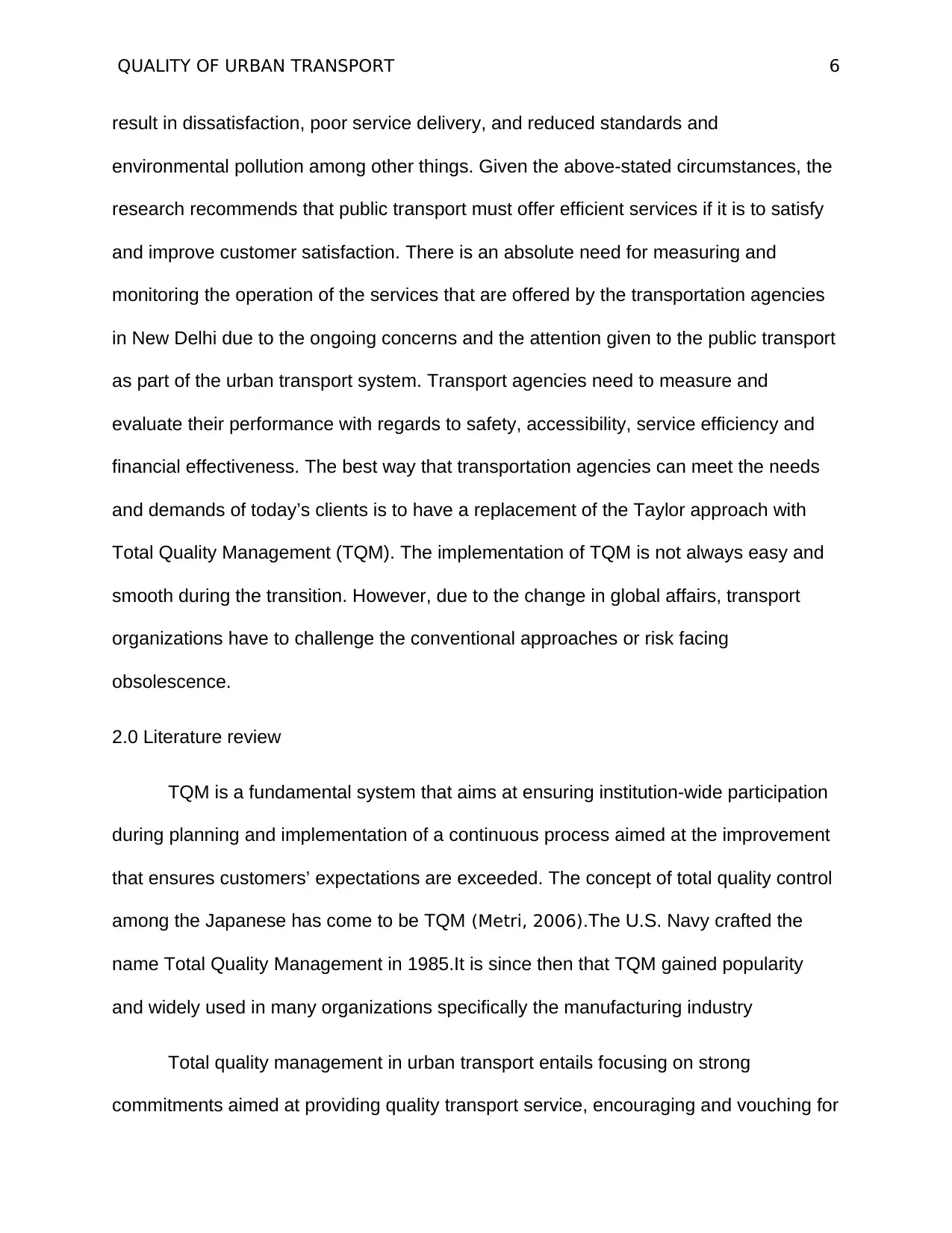
QUALITY OF URBAN TRANSPORT 6
result in dissatisfaction, poor service delivery, and reduced standards and
environmental pollution among other things. Given the above-stated circumstances, the
research recommends that public transport must offer efficient services if it is to satisfy
and improve customer satisfaction. There is an absolute need for measuring and
monitoring the operation of the services that are offered by the transportation agencies
in New Delhi due to the ongoing concerns and the attention given to the public transport
as part of the urban transport system. Transport agencies need to measure and
evaluate their performance with regards to safety, accessibility, service efficiency and
financial effectiveness. The best way that transportation agencies can meet the needs
and demands of today’s clients is to have a replacement of the Taylor approach with
Total Quality Management (TQM). The implementation of TQM is not always easy and
smooth during the transition. However, due to the change in global affairs, transport
organizations have to challenge the conventional approaches or risk facing
obsolescence.
2.0 Literature review
TQM is a fundamental system that aims at ensuring institution-wide participation
during planning and implementation of a continuous process aimed at the improvement
that ensures customers’ expectations are exceeded. The concept of total quality control
among the Japanese has come to be TQM (Metri, 2006).The U.S. Navy crafted the
name Total Quality Management in 1985.It is since then that TQM gained popularity
and widely used in many organizations specifically the manufacturing industry
Total quality management in urban transport entails focusing on strong
commitments aimed at providing quality transport service, encouraging and vouching for
result in dissatisfaction, poor service delivery, and reduced standards and
environmental pollution among other things. Given the above-stated circumstances, the
research recommends that public transport must offer efficient services if it is to satisfy
and improve customer satisfaction. There is an absolute need for measuring and
monitoring the operation of the services that are offered by the transportation agencies
in New Delhi due to the ongoing concerns and the attention given to the public transport
as part of the urban transport system. Transport agencies need to measure and
evaluate their performance with regards to safety, accessibility, service efficiency and
financial effectiveness. The best way that transportation agencies can meet the needs
and demands of today’s clients is to have a replacement of the Taylor approach with
Total Quality Management (TQM). The implementation of TQM is not always easy and
smooth during the transition. However, due to the change in global affairs, transport
organizations have to challenge the conventional approaches or risk facing
obsolescence.
2.0 Literature review
TQM is a fundamental system that aims at ensuring institution-wide participation
during planning and implementation of a continuous process aimed at the improvement
that ensures customers’ expectations are exceeded. The concept of total quality control
among the Japanese has come to be TQM (Metri, 2006).The U.S. Navy crafted the
name Total Quality Management in 1985.It is since then that TQM gained popularity
and widely used in many organizations specifically the manufacturing industry
Total quality management in urban transport entails focusing on strong
commitments aimed at providing quality transport service, encouraging and vouching for
⊘ This is a preview!⊘
Do you want full access?
Subscribe today to unlock all pages.

Trusted by 1+ million students worldwide
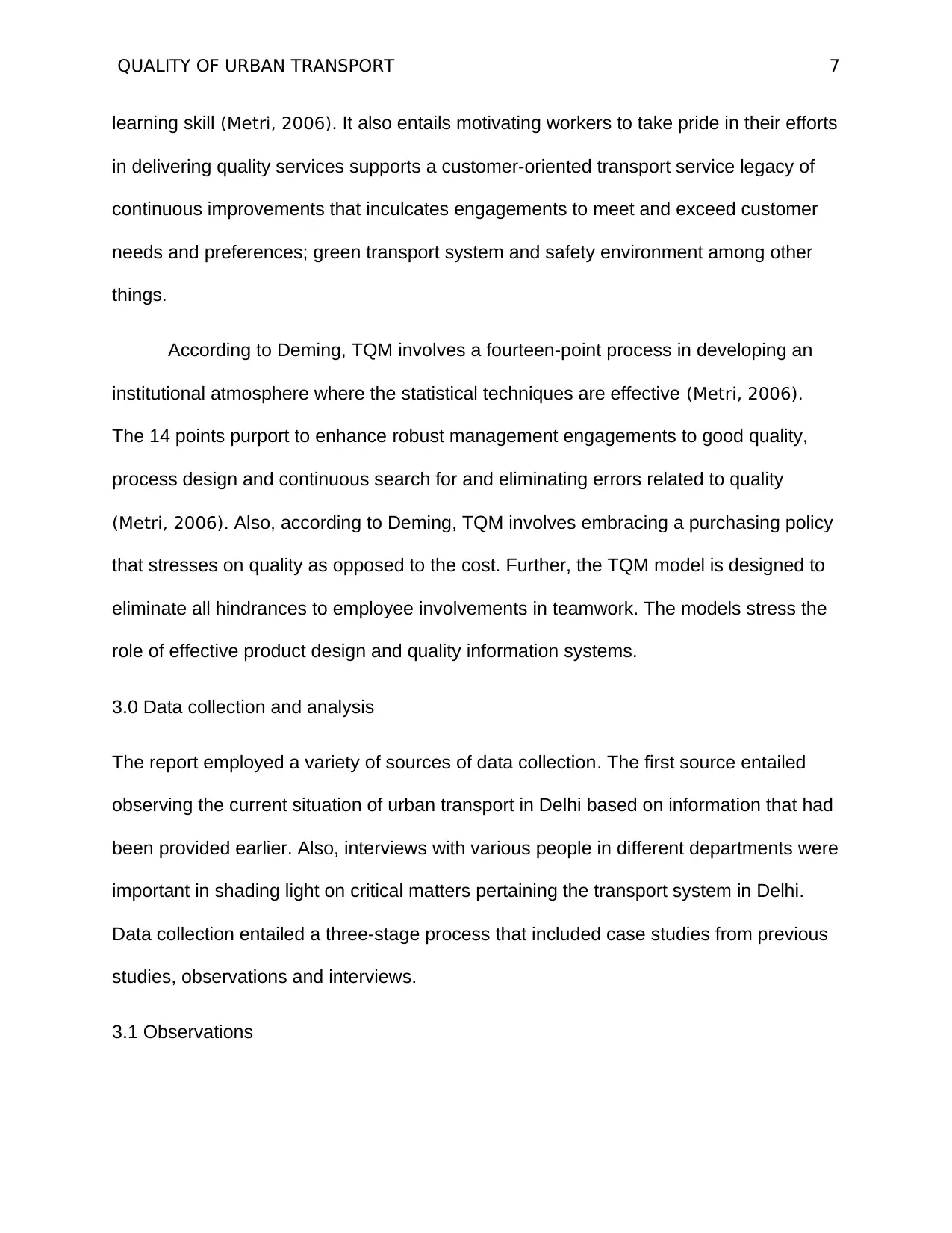
QUALITY OF URBAN TRANSPORT 7
learning skill (Metri, 2006). It also entails motivating workers to take pride in their efforts
in delivering quality services supports a customer-oriented transport service legacy of
continuous improvements that inculcates engagements to meet and exceed customer
needs and preferences; green transport system and safety environment among other
things.
According to Deming, TQM involves a fourteen-point process in developing an
institutional atmosphere where the statistical techniques are effective (Metri, 2006).
The 14 points purport to enhance robust management engagements to good quality,
process design and continuous search for and eliminating errors related to quality
(Metri, 2006). Also, according to Deming, TQM involves embracing a purchasing policy
that stresses on quality as opposed to the cost. Further, the TQM model is designed to
eliminate all hindrances to employee involvements in teamwork. The models stress the
role of effective product design and quality information systems.
3.0 Data collection and analysis
The report employed a variety of sources of data collection. The first source entailed
observing the current situation of urban transport in Delhi based on information that had
been provided earlier. Also, interviews with various people in different departments were
important in shading light on critical matters pertaining the transport system in Delhi.
Data collection entailed a three-stage process that included case studies from previous
studies, observations and interviews.
3.1 Observations
learning skill (Metri, 2006). It also entails motivating workers to take pride in their efforts
in delivering quality services supports a customer-oriented transport service legacy of
continuous improvements that inculcates engagements to meet and exceed customer
needs and preferences; green transport system and safety environment among other
things.
According to Deming, TQM involves a fourteen-point process in developing an
institutional atmosphere where the statistical techniques are effective (Metri, 2006).
The 14 points purport to enhance robust management engagements to good quality,
process design and continuous search for and eliminating errors related to quality
(Metri, 2006). Also, according to Deming, TQM involves embracing a purchasing policy
that stresses on quality as opposed to the cost. Further, the TQM model is designed to
eliminate all hindrances to employee involvements in teamwork. The models stress the
role of effective product design and quality information systems.
3.0 Data collection and analysis
The report employed a variety of sources of data collection. The first source entailed
observing the current situation of urban transport in Delhi based on information that had
been provided earlier. Also, interviews with various people in different departments were
important in shading light on critical matters pertaining the transport system in Delhi.
Data collection entailed a three-stage process that included case studies from previous
studies, observations and interviews.
3.1 Observations
Paraphrase This Document
Need a fresh take? Get an instant paraphrase of this document with our AI Paraphraser
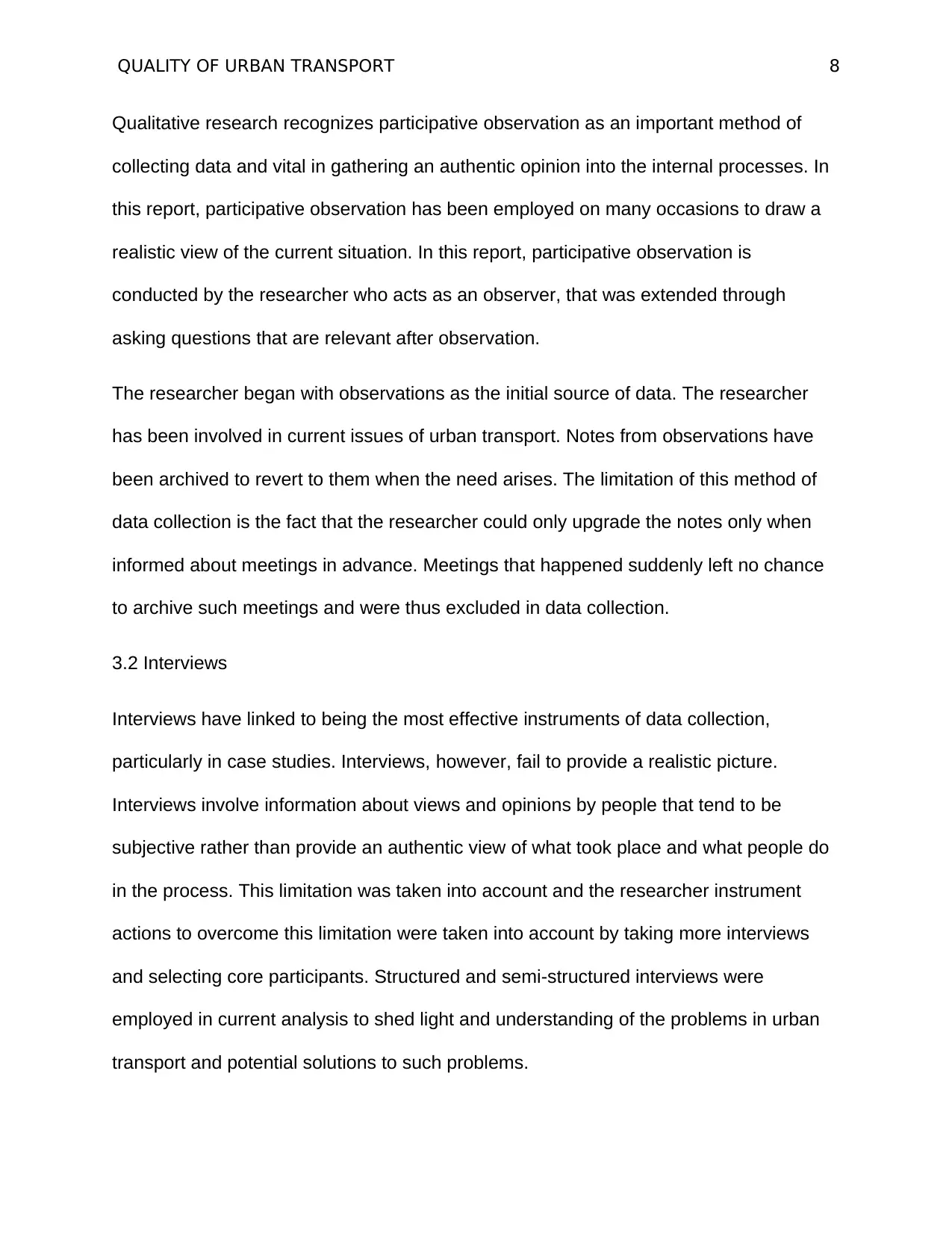
QUALITY OF URBAN TRANSPORT 8
Qualitative research recognizes participative observation as an important method of
collecting data and vital in gathering an authentic opinion into the internal processes. In
this report, participative observation has been employed on many occasions to draw a
realistic view of the current situation. In this report, participative observation is
conducted by the researcher who acts as an observer, that was extended through
asking questions that are relevant after observation.
The researcher began with observations as the initial source of data. The researcher
has been involved in current issues of urban transport. Notes from observations have
been archived to revert to them when the need arises. The limitation of this method of
data collection is the fact that the researcher could only upgrade the notes only when
informed about meetings in advance. Meetings that happened suddenly left no chance
to archive such meetings and were thus excluded in data collection.
3.2 Interviews
Interviews have linked to being the most effective instruments of data collection,
particularly in case studies. Interviews, however, fail to provide a realistic picture.
Interviews involve information about views and opinions by people that tend to be
subjective rather than provide an authentic view of what took place and what people do
in the process. This limitation was taken into account and the researcher instrument
actions to overcome this limitation were taken into account by taking more interviews
and selecting core participants. Structured and semi-structured interviews were
employed in current analysis to shed light and understanding of the problems in urban
transport and potential solutions to such problems.
Qualitative research recognizes participative observation as an important method of
collecting data and vital in gathering an authentic opinion into the internal processes. In
this report, participative observation has been employed on many occasions to draw a
realistic view of the current situation. In this report, participative observation is
conducted by the researcher who acts as an observer, that was extended through
asking questions that are relevant after observation.
The researcher began with observations as the initial source of data. The researcher
has been involved in current issues of urban transport. Notes from observations have
been archived to revert to them when the need arises. The limitation of this method of
data collection is the fact that the researcher could only upgrade the notes only when
informed about meetings in advance. Meetings that happened suddenly left no chance
to archive such meetings and were thus excluded in data collection.
3.2 Interviews
Interviews have linked to being the most effective instruments of data collection,
particularly in case studies. Interviews, however, fail to provide a realistic picture.
Interviews involve information about views and opinions by people that tend to be
subjective rather than provide an authentic view of what took place and what people do
in the process. This limitation was taken into account and the researcher instrument
actions to overcome this limitation were taken into account by taking more interviews
and selecting core participants. Structured and semi-structured interviews were
employed in current analysis to shed light and understanding of the problems in urban
transport and potential solutions to such problems.
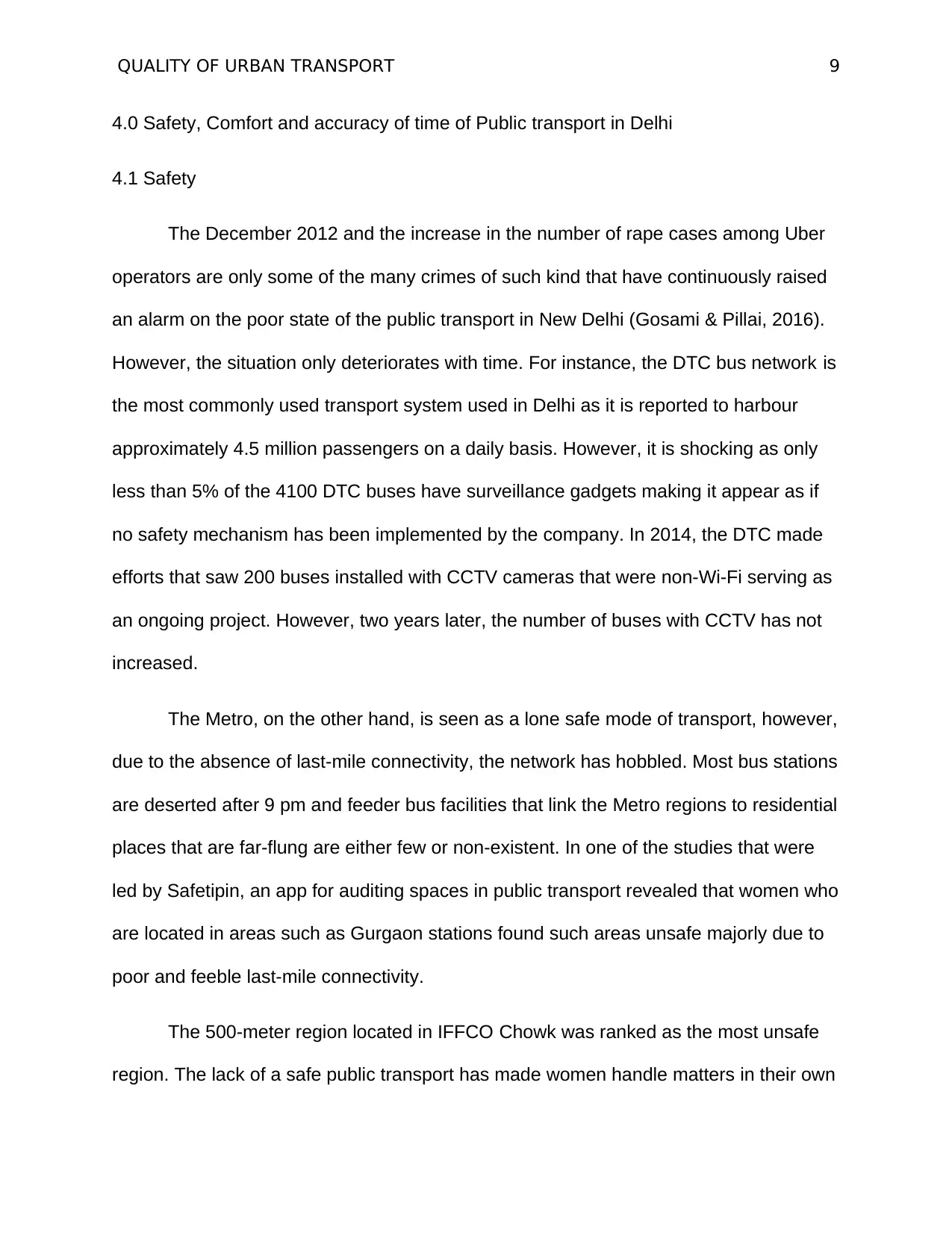
QUALITY OF URBAN TRANSPORT 9
4.0 Safety, Comfort and accuracy of time of Public transport in Delhi
4.1 Safety
The December 2012 and the increase in the number of rape cases among Uber
operators are only some of the many crimes of such kind that have continuously raised
an alarm on the poor state of the public transport in New Delhi (Gosami & Pillai, 2016).
However, the situation only deteriorates with time. For instance, the DTC bus network is
the most commonly used transport system used in Delhi as it is reported to harbour
approximately 4.5 million passengers on a daily basis. However, it is shocking as only
less than 5% of the 4100 DTC buses have surveillance gadgets making it appear as if
no safety mechanism has been implemented by the company. In 2014, the DTC made
efforts that saw 200 buses installed with CCTV cameras that were non-Wi-Fi serving as
an ongoing project. However, two years later, the number of buses with CCTV has not
increased.
The Metro, on the other hand, is seen as a lone safe mode of transport, however,
due to the absence of last-mile connectivity, the network has hobbled. Most bus stations
are deserted after 9 pm and feeder bus facilities that link the Metro regions to residential
places that are far-flung are either few or non-existent. In one of the studies that were
led by Safetipin, an app for auditing spaces in public transport revealed that women who
are located in areas such as Gurgaon stations found such areas unsafe majorly due to
poor and feeble last-mile connectivity.
The 500-meter region located in IFFCO Chowk was ranked as the most unsafe
region. The lack of a safe public transport has made women handle matters in their own
4.0 Safety, Comfort and accuracy of time of Public transport in Delhi
4.1 Safety
The December 2012 and the increase in the number of rape cases among Uber
operators are only some of the many crimes of such kind that have continuously raised
an alarm on the poor state of the public transport in New Delhi (Gosami & Pillai, 2016).
However, the situation only deteriorates with time. For instance, the DTC bus network is
the most commonly used transport system used in Delhi as it is reported to harbour
approximately 4.5 million passengers on a daily basis. However, it is shocking as only
less than 5% of the 4100 DTC buses have surveillance gadgets making it appear as if
no safety mechanism has been implemented by the company. In 2014, the DTC made
efforts that saw 200 buses installed with CCTV cameras that were non-Wi-Fi serving as
an ongoing project. However, two years later, the number of buses with CCTV has not
increased.
The Metro, on the other hand, is seen as a lone safe mode of transport, however,
due to the absence of last-mile connectivity, the network has hobbled. Most bus stations
are deserted after 9 pm and feeder bus facilities that link the Metro regions to residential
places that are far-flung are either few or non-existent. In one of the studies that were
led by Safetipin, an app for auditing spaces in public transport revealed that women who
are located in areas such as Gurgaon stations found such areas unsafe majorly due to
poor and feeble last-mile connectivity.
The 500-meter region located in IFFCO Chowk was ranked as the most unsafe
region. The lack of a safe public transport has made women handle matters in their own
⊘ This is a preview!⊘
Do you want full access?
Subscribe today to unlock all pages.

Trusted by 1+ million students worldwide
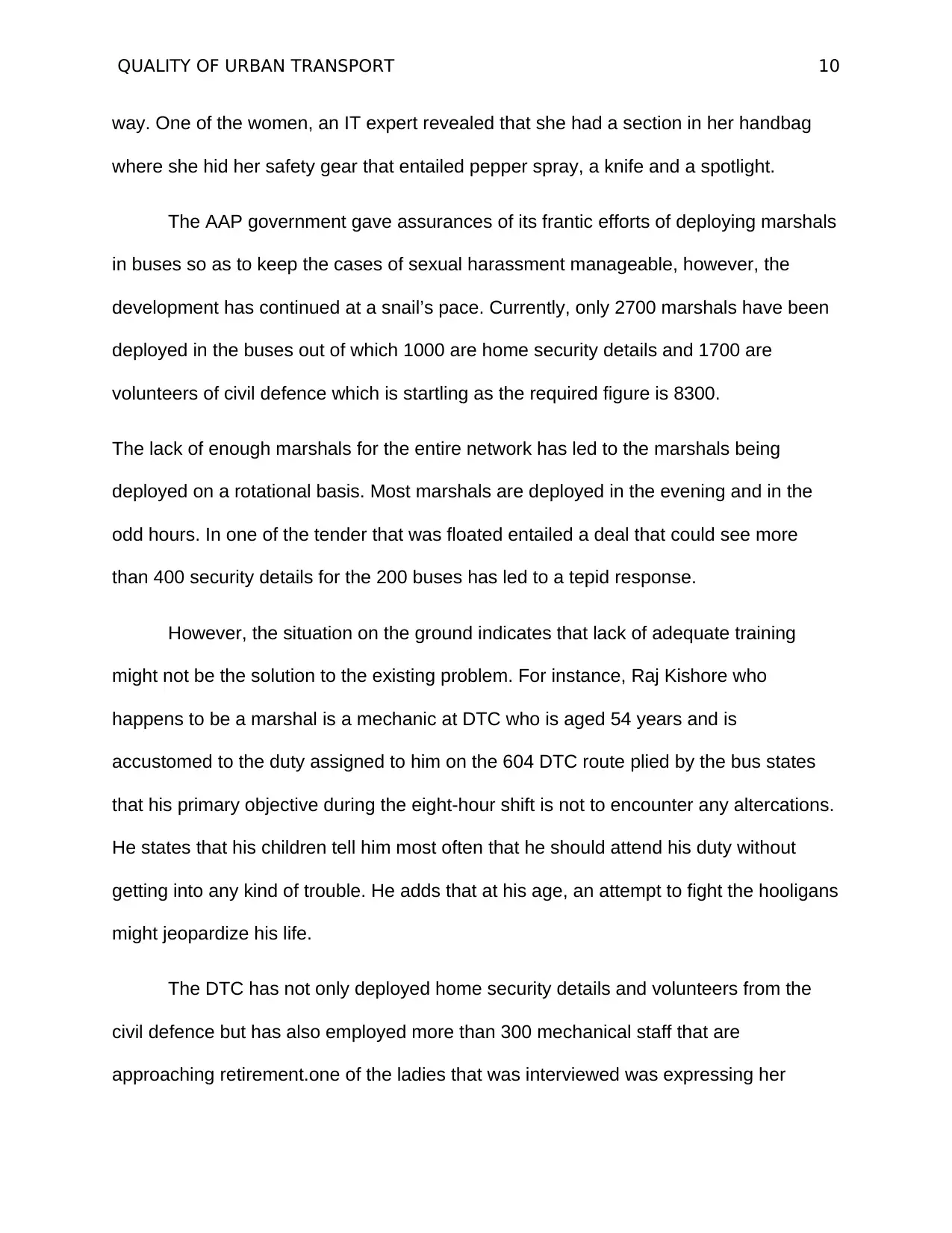
QUALITY OF URBAN TRANSPORT 10
way. One of the women, an IT expert revealed that she had a section in her handbag
where she hid her safety gear that entailed pepper spray, a knife and a spotlight.
The AAP government gave assurances of its frantic efforts of deploying marshals
in buses so as to keep the cases of sexual harassment manageable, however, the
development has continued at a snail’s pace. Currently, only 2700 marshals have been
deployed in the buses out of which 1000 are home security details and 1700 are
volunteers of civil defence which is startling as the required figure is 8300.
The lack of enough marshals for the entire network has led to the marshals being
deployed on a rotational basis. Most marshals are deployed in the evening and in the
odd hours. In one of the tender that was floated entailed a deal that could see more
than 400 security details for the 200 buses has led to a tepid response.
However, the situation on the ground indicates that lack of adequate training
might not be the solution to the existing problem. For instance, Raj Kishore who
happens to be a marshal is a mechanic at DTC who is aged 54 years and is
accustomed to the duty assigned to him on the 604 DTC route plied by the bus states
that his primary objective during the eight-hour shift is not to encounter any altercations.
He states that his children tell him most often that he should attend his duty without
getting into any kind of trouble. He adds that at his age, an attempt to fight the hooligans
might jeopardize his life.
The DTC has not only deployed home security details and volunteers from the
civil defence but has also employed more than 300 mechanical staff that are
approaching retirement.one of the ladies that was interviewed was expressing her
way. One of the women, an IT expert revealed that she had a section in her handbag
where she hid her safety gear that entailed pepper spray, a knife and a spotlight.
The AAP government gave assurances of its frantic efforts of deploying marshals
in buses so as to keep the cases of sexual harassment manageable, however, the
development has continued at a snail’s pace. Currently, only 2700 marshals have been
deployed in the buses out of which 1000 are home security details and 1700 are
volunteers of civil defence which is startling as the required figure is 8300.
The lack of enough marshals for the entire network has led to the marshals being
deployed on a rotational basis. Most marshals are deployed in the evening and in the
odd hours. In one of the tender that was floated entailed a deal that could see more
than 400 security details for the 200 buses has led to a tepid response.
However, the situation on the ground indicates that lack of adequate training
might not be the solution to the existing problem. For instance, Raj Kishore who
happens to be a marshal is a mechanic at DTC who is aged 54 years and is
accustomed to the duty assigned to him on the 604 DTC route plied by the bus states
that his primary objective during the eight-hour shift is not to encounter any altercations.
He states that his children tell him most often that he should attend his duty without
getting into any kind of trouble. He adds that at his age, an attempt to fight the hooligans
might jeopardize his life.
The DTC has not only deployed home security details and volunteers from the
civil defence but has also employed more than 300 mechanical staff that are
approaching retirement.one of the ladies that was interviewed was expressing her
Paraphrase This Document
Need a fresh take? Get an instant paraphrase of this document with our AI Paraphraser
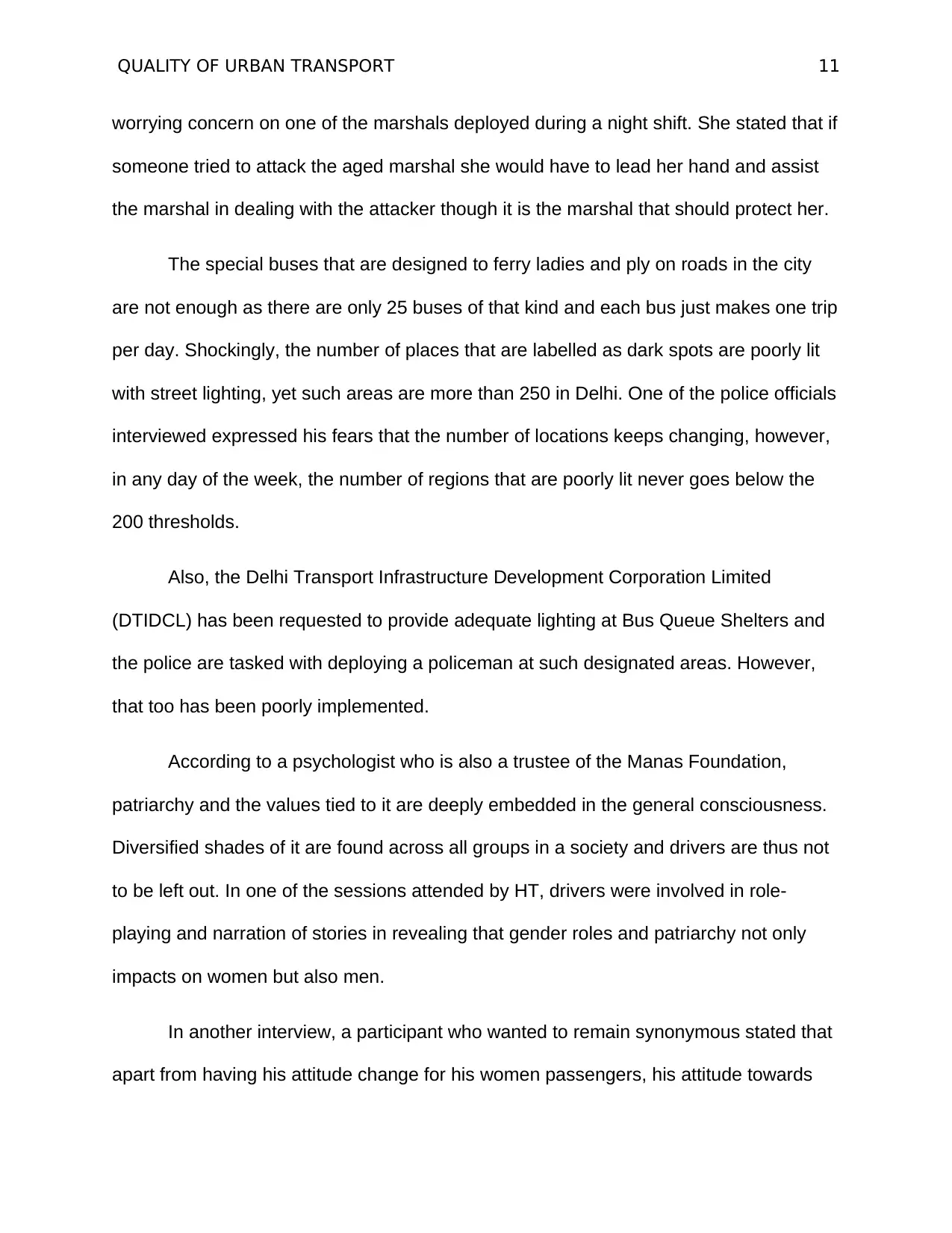
QUALITY OF URBAN TRANSPORT 11
worrying concern on one of the marshals deployed during a night shift. She stated that if
someone tried to attack the aged marshal she would have to lead her hand and assist
the marshal in dealing with the attacker though it is the marshal that should protect her.
The special buses that are designed to ferry ladies and ply on roads in the city
are not enough as there are only 25 buses of that kind and each bus just makes one trip
per day. Shockingly, the number of places that are labelled as dark spots are poorly lit
with street lighting, yet such areas are more than 250 in Delhi. One of the police officials
interviewed expressed his fears that the number of locations keeps changing, however,
in any day of the week, the number of regions that are poorly lit never goes below the
200 thresholds.
Also, the Delhi Transport Infrastructure Development Corporation Limited
(DTIDCL) has been requested to provide adequate lighting at Bus Queue Shelters and
the police are tasked with deploying a policeman at such designated areas. However,
that too has been poorly implemented.
According to a psychologist who is also a trustee of the Manas Foundation,
patriarchy and the values tied to it are deeply embedded in the general consciousness.
Diversified shades of it are found across all groups in a society and drivers are thus not
to be left out. In one of the sessions attended by HT, drivers were involved in role-
playing and narration of stories in revealing that gender roles and patriarchy not only
impacts on women but also men.
In another interview, a participant who wanted to remain synonymous stated that
apart from having his attitude change for his women passengers, his attitude towards
worrying concern on one of the marshals deployed during a night shift. She stated that if
someone tried to attack the aged marshal she would have to lead her hand and assist
the marshal in dealing with the attacker though it is the marshal that should protect her.
The special buses that are designed to ferry ladies and ply on roads in the city
are not enough as there are only 25 buses of that kind and each bus just makes one trip
per day. Shockingly, the number of places that are labelled as dark spots are poorly lit
with street lighting, yet such areas are more than 250 in Delhi. One of the police officials
interviewed expressed his fears that the number of locations keeps changing, however,
in any day of the week, the number of regions that are poorly lit never goes below the
200 thresholds.
Also, the Delhi Transport Infrastructure Development Corporation Limited
(DTIDCL) has been requested to provide adequate lighting at Bus Queue Shelters and
the police are tasked with deploying a policeman at such designated areas. However,
that too has been poorly implemented.
According to a psychologist who is also a trustee of the Manas Foundation,
patriarchy and the values tied to it are deeply embedded in the general consciousness.
Diversified shades of it are found across all groups in a society and drivers are thus not
to be left out. In one of the sessions attended by HT, drivers were involved in role-
playing and narration of stories in revealing that gender roles and patriarchy not only
impacts on women but also men.
In another interview, a participant who wanted to remain synonymous stated that
apart from having his attitude change for his women passengers, his attitude towards
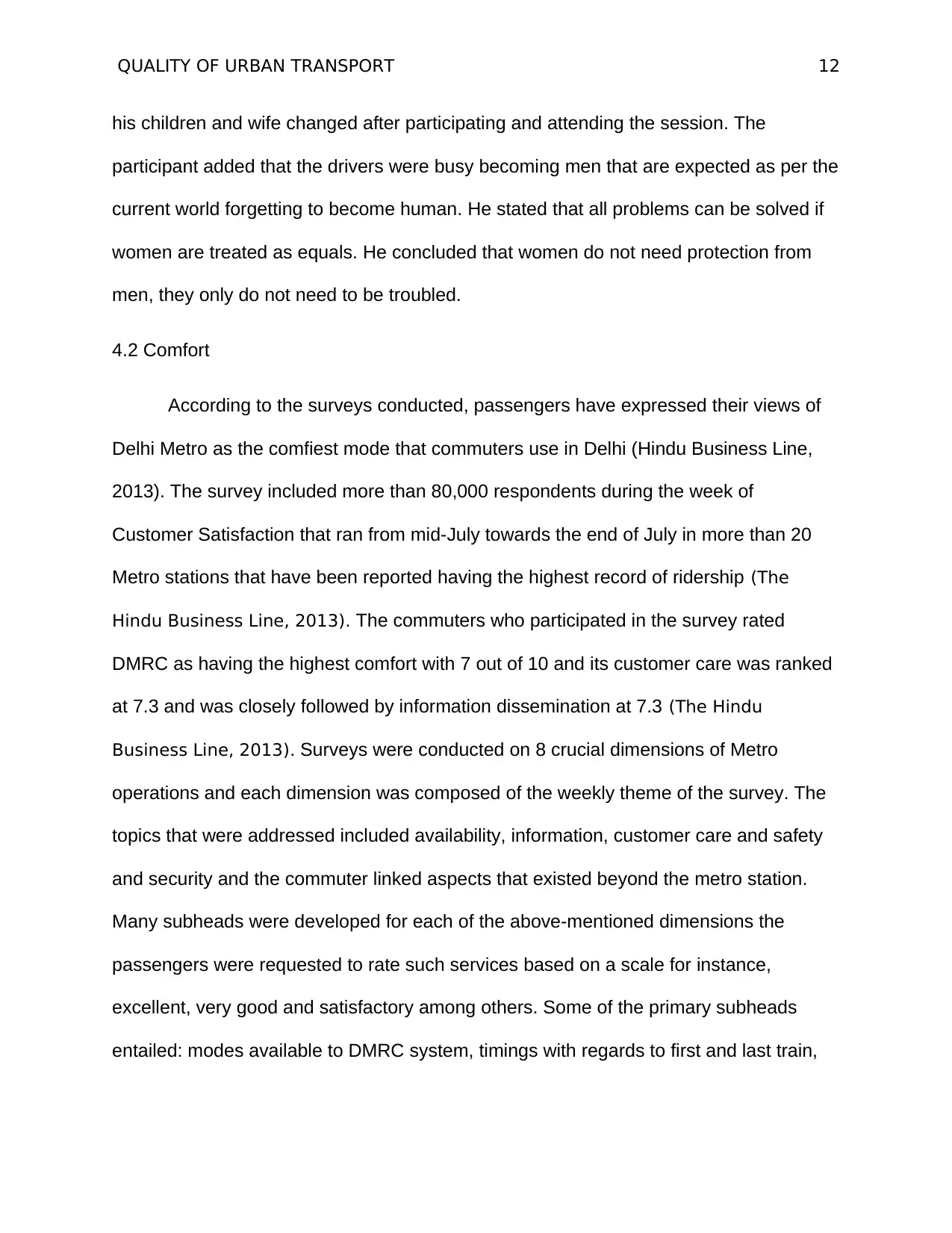
QUALITY OF URBAN TRANSPORT 12
his children and wife changed after participating and attending the session. The
participant added that the drivers were busy becoming men that are expected as per the
current world forgetting to become human. He stated that all problems can be solved if
women are treated as equals. He concluded that women do not need protection from
men, they only do not need to be troubled.
4.2 Comfort
According to the surveys conducted, passengers have expressed their views of
Delhi Metro as the comfiest mode that commuters use in Delhi (Hindu Business Line,
2013). The survey included more than 80,000 respondents during the week of
Customer Satisfaction that ran from mid-July towards the end of July in more than 20
Metro stations that have been reported having the highest record of ridership (The
Hindu Business Line, 2013). The commuters who participated in the survey rated
DMRC as having the highest comfort with 7 out of 10 and its customer care was ranked
at 7.3 and was closely followed by information dissemination at 7.3 (The Hindu
Business Line, 2013). Surveys were conducted on 8 crucial dimensions of Metro
operations and each dimension was composed of the weekly theme of the survey. The
topics that were addressed included availability, information, customer care and safety
and security and the commuter linked aspects that existed beyond the metro station.
Many subheads were developed for each of the above-mentioned dimensions the
passengers were requested to rate such services based on a scale for instance,
excellent, very good and satisfactory among others. Some of the primary subheads
entailed: modes available to DMRC system, timings with regards to first and last train,
his children and wife changed after participating and attending the session. The
participant added that the drivers were busy becoming men that are expected as per the
current world forgetting to become human. He stated that all problems can be solved if
women are treated as equals. He concluded that women do not need protection from
men, they only do not need to be troubled.
4.2 Comfort
According to the surveys conducted, passengers have expressed their views of
Delhi Metro as the comfiest mode that commuters use in Delhi (Hindu Business Line,
2013). The survey included more than 80,000 respondents during the week of
Customer Satisfaction that ran from mid-July towards the end of July in more than 20
Metro stations that have been reported having the highest record of ridership (The
Hindu Business Line, 2013). The commuters who participated in the survey rated
DMRC as having the highest comfort with 7 out of 10 and its customer care was ranked
at 7.3 and was closely followed by information dissemination at 7.3 (The Hindu
Business Line, 2013). Surveys were conducted on 8 crucial dimensions of Metro
operations and each dimension was composed of the weekly theme of the survey. The
topics that were addressed included availability, information, customer care and safety
and security and the commuter linked aspects that existed beyond the metro station.
Many subheads were developed for each of the above-mentioned dimensions the
passengers were requested to rate such services based on a scale for instance,
excellent, very good and satisfactory among others. Some of the primary subheads
entailed: modes available to DMRC system, timings with regards to first and last train,
⊘ This is a preview!⊘
Do you want full access?
Subscribe today to unlock all pages.

Trusted by 1+ million students worldwide
1 out of 37
Related Documents
Your All-in-One AI-Powered Toolkit for Academic Success.
+13062052269
info@desklib.com
Available 24*7 on WhatsApp / Email
![[object Object]](/_next/static/media/star-bottom.7253800d.svg)
Unlock your academic potential
Copyright © 2020–2025 A2Z Services. All Rights Reserved. Developed and managed by ZUCOL.



